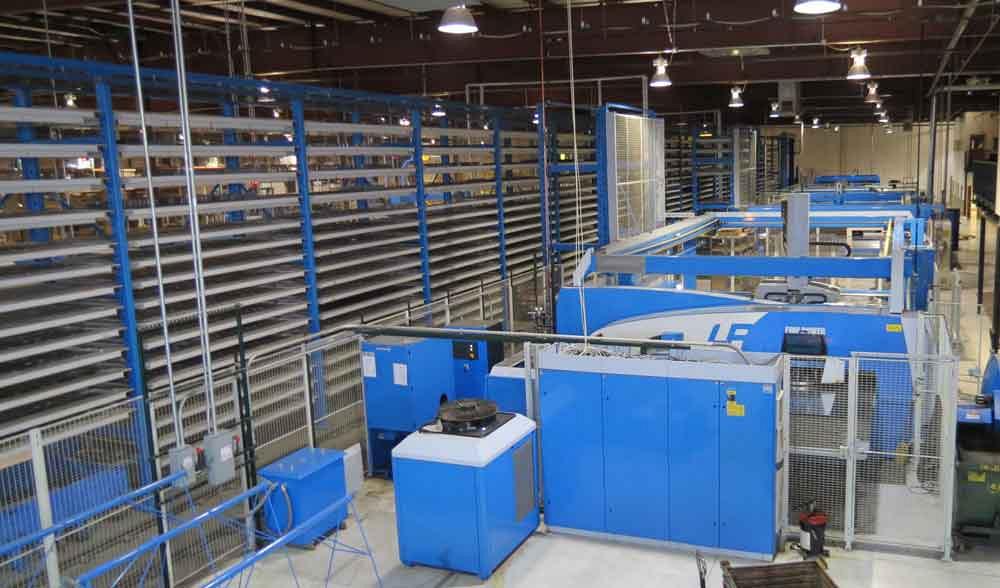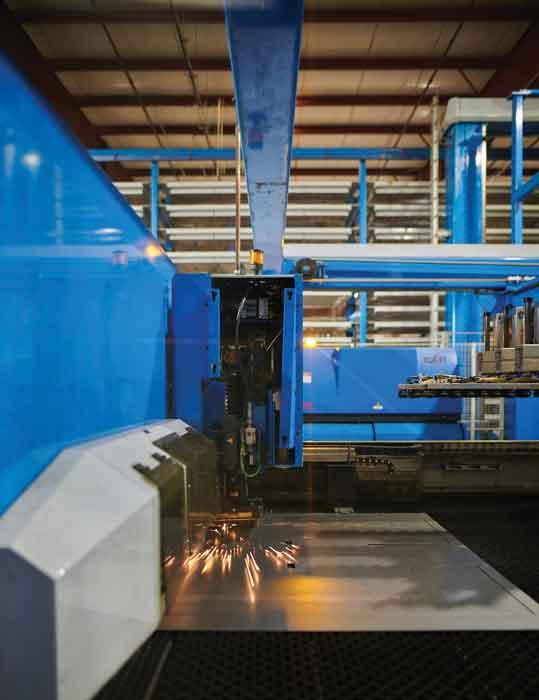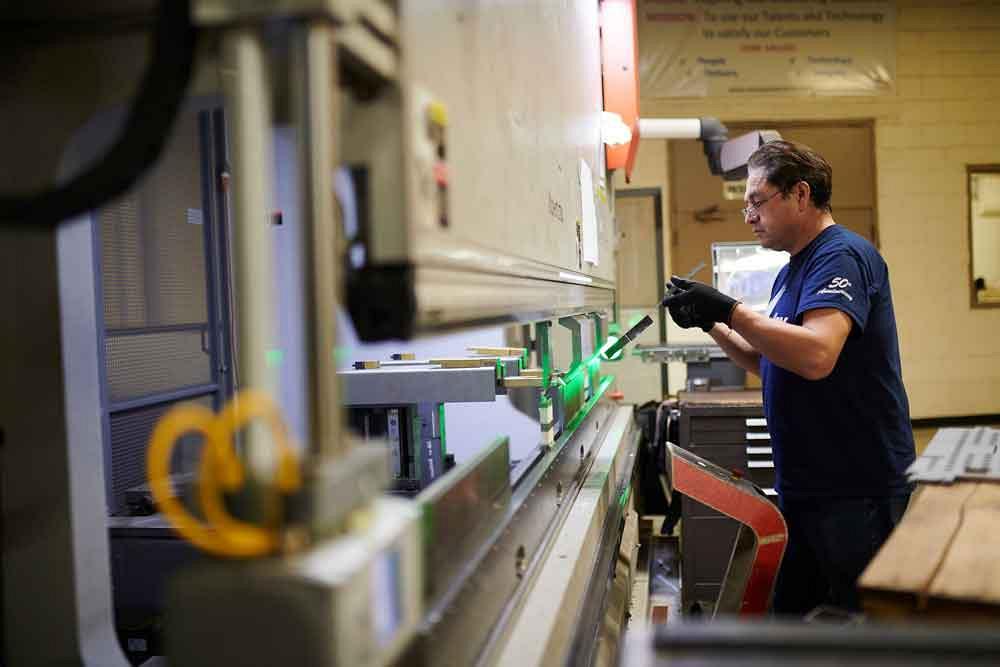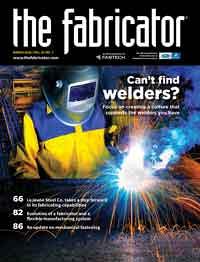Senior Editor
- FMA
- The Fabricator
- FABTECH
- Canadian Metalworking
Categories
- Additive Manufacturing
- Aluminum Welding
- Arc Welding
- Assembly and Joining
- Automation and Robotics
- Bending and Forming
- Consumables
- Cutting and Weld Prep
- Electric Vehicles
- En Español
- Finishing
- Hydroforming
- Laser Cutting
- Laser Welding
- Machining
- Manufacturing Software
- Materials Handling
- Metals/Materials
- Oxyfuel Cutting
- Plasma Cutting
- Power Tools
- Punching and Other Holemaking
- Roll Forming
- Safety
- Sawing
- Shearing
- Shop Management
- Testing and Measuring
- Tube and Pipe Fabrication
- Tube and Pipe Production
- Waterjet Cutting
Industry Directory
Webcasts
Podcasts
FAB 40
Advertise
Subscribe
Account Login
Search
Cutting's Current State: Flexibility rules in sheet metal fabrication
Nu-Way Industries aims to bolster machinery speed and, more importance, delivery performance
- By Tim Heston
- March 9, 2020
- Article
- Laser Cutting

A robot manipulates an enclosure under a remote laser welding beam. The highly productive cell is adjacent to Nu-Way’s FMS.
Editor's note: This is the third part of our four-part Cutting's Current State series to commemorate our 50th anniversary. Check out Part I, Part II, and Part IV.
Walk Nu-Way Industries' shop floor and you basically see two factories. One side of the shop has your standard custom fabrication equipment: CNC punch tables, fiber lasers, press brakes, manual and robotic welding cells. The other side has a flexible manufacturing system (FMS) in action. The automation has shearing, laser cutting, punching, bending, and 260 cassettes for automated storage and retrieval, all in one floor-spanning system.
The FMS is no longer a new concept, of course. Nu-Way installed its Prima Power system 16 years ago. Going back to the late 1990s and early 2000s, FMSs often were considered the wave of the future and the industry’s response to emerging low-labor-cost countries like China.
Nu-Way’s FMS investment is a testament to that. As Steve Wiseman, executive vice president and chief operating officer, recalled, “The automation allowed us to bring back an entire family of parts that we had previously lost to China—and bring it back cost-effectively.”
Cost makes all the difference, and when you get right down to it, fabrication technology, including laser cutting, is all about cost reduction somewhere in the supply chain. It might be about the cost of the sheet metal component itself, or it might be about savings somewhere else. A customer might pay a per-piece premium for quick response, low quantity, and high quality, but it’s doing so to either save or make money elsewhere.
So if it is all about cost reduction, why isn’t FMS automation everywhere? Grossly oversimplified, one size doesn’t fit all, and fabricators have many ways to take cost out of a fabricated component. It’s why the technology at Nu-Way remains so diverse.
Road to the FMS
The FABRICATOR has covered laser cutting since 1974, when the publication was just 4 years old. The magazine and laser cutting really grew up together. So to celebrate The FABRICATOR’s 50th year, we’re analyzing cutting’s current state, describing where things stand on various shop floors after so many years of unrelenting innovation.
As it turns out, Nu-Way also grew up with The FABRICATOR. In 2018 the company also celebrated 50 years in business. Its annual revenue now surpasses $45 million, and its cutting capability has come a long way. Besides the CO2 laser in the FMS, which is designed for sheet metal 10 gauge and thinner, the operation replaced its last stand-alone CO2 laser late last year—with an 8-kW TRUMPF solid-state laser, no less, complete with part loading/unloading automation that incorporates a parts-offloading conveyor.
“That machine will cut up to 1-in. material,” Wiseman said. “We typically top out at about ½ to 5/8 in. We’re really not doing anything heavier than that. But we do cut quite a bit of 7 ga. to 3/8. We’re not just a light-gauge operation.”
Compare that 8-kW laser with some of Nu-Way’s earliest cutting systems, including a few small-table, 30-station turret punches along with some larger 50-ton machines. For a time the company even used a punch/plasma combo machine, with mixed results (these were the days before high-def plasma).
Then came the CO2 lasers with powers up to 4 kW, all of which complemented Nu-Way’s punching capability. “So in the 1990s we had punching and stand-alone laser cutting, and which machine we used for what job was part-dependent,” Wiseman said, “just like everybody else.”
An opportunity in the early 2000s changed everything, and soon Nu-Way’s shop floor wasn’t like everybody else’s. A large industrial customer that sent work overseas was hoping to bring it back—for the right price. The FMS, Wiseman said, allowed Nu-Way to meet and even beat that price.
The customer wanted Nu-Way to produce a wide-ranging family of parts, and all of them happened to have the dimensions that fit the capability of the Prima Power (then Finn-Power) FMS. It was all lighter-gauge material, with flange locations and heights perfectly suited for the FMS’s panel bender.
Wiseman conceded that it was a big investment, but 16 years later he can say with confidence that the investment paid off many times over. The contract that spurred the investment is still in place, and the work typically takes 50% of the machine’s capacity. Nu-Way then fills the remaining capacity with other jobs.
Considering the FMS’s size, you might think that Nu-Way reserves it for high-volume work. The automation can produce high-volume work, of course, but volume really isn’t a deciding factor. “It’s not so much about volume,” Wiseman said. “It’s really a process decision, whether or not the processes are a good fit for the equipment.”
To that end, the company has built those considerations into its new product introduction process. A product design might need some tweaking—a flange height adjustment, a bend-geometry change (a negative bend on the first bend only, for instance), perhaps a change to a cutout geometry. But thanks to the FMS’s capabilities, the savings sometimes can be massive, so the costs associated with a part redesign make sense.
“Again, it really comes down to cost savings,” Wiseman said. “If we can show a customer a decent savings on a process change, they’ll consider it. If we can have a customer revise a part so that, say, we can bend it on the automated bender and laser-weld the product, then we can usually show them enough of an ROI so that it makes sense for them to do it.”
And yes, he did say “laser welding,” another capability that sets Nu-Way apart. A remote laser beam welding cell sits conveniently, and not coincidentally, next to the FMS. A robot positions the workpiece under a remote laser beam system that moves between weld locations in microseconds. This gives workpieces an immense velocity boost through the automated factory.
Considering the throughput and flexibility of Nu-Way’s FMS, one might expect that it would be responsible for the majority of the company’s revenue. But that’s not the case.
“It actually represents about 20% of our overall revenue,” Wiseman said. “But that’s a little misleading, because the majority of products that go through our FMS are carbon steel.”

Nu-Way’s flexible manufacturing system spans the length of the factory floor. The system has been producing parts consistently for 16 years.
The conventional fabrication factory runs a significant amount of stainless and aluminum, much of it going to the food service industry. Removing material costs from the equation, the FMS produces about 30% of the company’s total output. That’s not incredibly high, but it’s still a significant percentage considering all the cutting resources Nu-Way has in its conventional fabrication factory. Its 10 primary stand-alone cutting machines include various punches, a punch/shear combo, a punch/laser combo, and fiber laser cutting machines from 2 to 8 kW. These systems use a range of material handling automation, from towers to automatic load/unload, as well as that conveyor-based unload system on the 8-kW system.
Moreover, the FMS’s two primary cutting machines—a punch/shear and punch/laser combo—are both 16 years old, whereas the other factory has a collection of fiber lasers that are just several years old. In this context, a 16-year-old FMS producing 20% of shop revenue is pretty impressive.
A Mix of Batch and Single-piece Flow
Wiseman, who has worked at Nu-Way for 33 years, has some perspective on how blanking technology has evolved. When he visits FABTECH and samples new technology, including the new FMSs from Prima Power and others, the focus on single-piece flow impresses him. Parts travel right from cutting to bending in sequence, with minimal inventory buffers between processes. Other FMSs shuttle pieces directly from cutting to bending while also sending some pieces to the storage system.
Nu-Way’s FMS does not shuttle parts from cutting immediately to bending. It instead cuts a batch of parts and shuttles them in a cassette to the storage system, then retrieves the cassette and delivers parts to the forming station.
The FMS’s panel bender can change over very quickly, of course. It bends with universal tools, after all, with clamping tools adjusting for different bend lengths. In some cases, a single cassette can store all the different parts a subassembly requires. The cassette presents all those parts to the panel bender, which then bends the pieces sequentially—a concept that works especially well if clamping tools arrange themselves in a “staged” setup that can accommodate all the different bend lengths and clearances that a kit of parts requires.Nu-Way has taken advantage of kit-based, single-piece processing when it makes sense, either at the FMS or other workstations. On occasion, though, challenges arise downstream. Wiseman recalled a product family of various trays destined for the food service industry. The components flowed smoothly to welding, where engineers developed fixturing that they thought could accommodate the entire range of parts from upstream.
“We designed that process around an entire family of parts,” Wiseman said. “We just had a lot of changeovers, and the fixturing was very complex. It just took time to change out all those fixtures. I still think it was a solid concept, and I think we learned some things that we just couldn’t have predicted otherwise.” In that case, the company shifted gears, reverted to traditional batch processing, and in doing so increased throughput and overall flexibility.
“Still, we have a tremendous amount of flexibility with that FMS,” Wiseman said. “It will run what I need it to run when I need it. And our customers have a lot of changing needs that can occur in a very short time window. So we have to be light on our feet.
“If we have a system that takes several hours to change over, and I’ve got to switch gears and produce parts for inventory replenishment the next morning, we could have serious challenges meeting the schedule. Compare that to just changing the program in the bender, and processing whatever we need through bending, hardware insertion, and laser welding, and getting it over to our paint line. We can do that very quickly.”
A Good Snapshot
Nu-Way’s shop floor gives a good snapshot of cutting’s current state in the industry. It has a mix of stand-alone machines, individual towers, load/unload automation, and, of course, a full-fledged FMS.
The faster and more flexible manufacturing processes become, the lower inventory buffers can be. Contract customers pull what they need, and Nu-Way has the capacity it needs to replenish quickly while at the same time fabricating an array of make-to-order jobs.
Nu-Way’s mix of technology might not be what many expected several decades ago, especially as FMSs started hitting the sheet metal market. After all, they offered truly flexible automation. As such systems evolved, perhaps manual operations would be a thing of the past?
That vision has come to pass for some products, but not for all. Much of that has to do with a part’s processing requirements; if a formed piece can’t lie flat and has extensive flange lengths, it’s probably not the best choice for an automated panel bender. Whether a job runs through automation or not depends on where the available capacity is. As anyone in the sheet metal world knows, when it rains, it pours, so the most successful shops have become expert jugglers when demand competes for finite resources.
In some respects Nu-Way’s shop floor is a microcosm of custom and contract sheet metal fabrication at large, with a mix of automation and manual processes. At the heart of it all is flexibility. All the laser cutting speed in the world doesn’t matter if a fabricator’s overall operation is inflexible, unable to give customers what they need, exactly when they need it.
About the Author

Tim Heston
2135 Point Blvd
Elgin, IL 60123
815-381-1314
Tim Heston, The Fabricator's senior editor, has covered the metal fabrication industry since 1998, starting his career at the American Welding Society's Welding Journal. Since then he has covered the full range of metal fabrication processes, from stamping, bending, and cutting to grinding and polishing. He joined The Fabricator's staff in October 2007.
Related Companies
subscribe now

The Fabricator is North America's leading magazine for the metal forming and fabricating industry. The magazine delivers the news, technical articles, and case histories that enable fabricators to do their jobs more efficiently. The Fabricator has served the industry since 1970.
start your free subscription- Stay connected from anywhere

Easily access valuable industry resources now with full access to the digital edition of The Fabricator.

Easily access valuable industry resources now with full access to the digital edition of The Welder.

Easily access valuable industry resources now with full access to the digital edition of The Tube and Pipe Journal.
- Podcasting
- Podcast:
- The Fabricator Podcast
- Published:
- 04/16/2024
- Running Time:
- 63:29
In this episode of The Fabricator Podcast, Caleb Chamberlain, co-founder and CEO of OSH Cut, discusses his company’s...
- Industry Events
16th Annual Safety Conference
- April 30 - May 1, 2024
- Elgin,
Pipe and Tube Conference
- May 21 - 22, 2024
- Omaha, NE
World-Class Roll Forming Workshop
- June 5 - 6, 2024
- Louisville, KY
Advanced Laser Application Workshop
- June 25 - 27, 2024
- Novi, MI

































